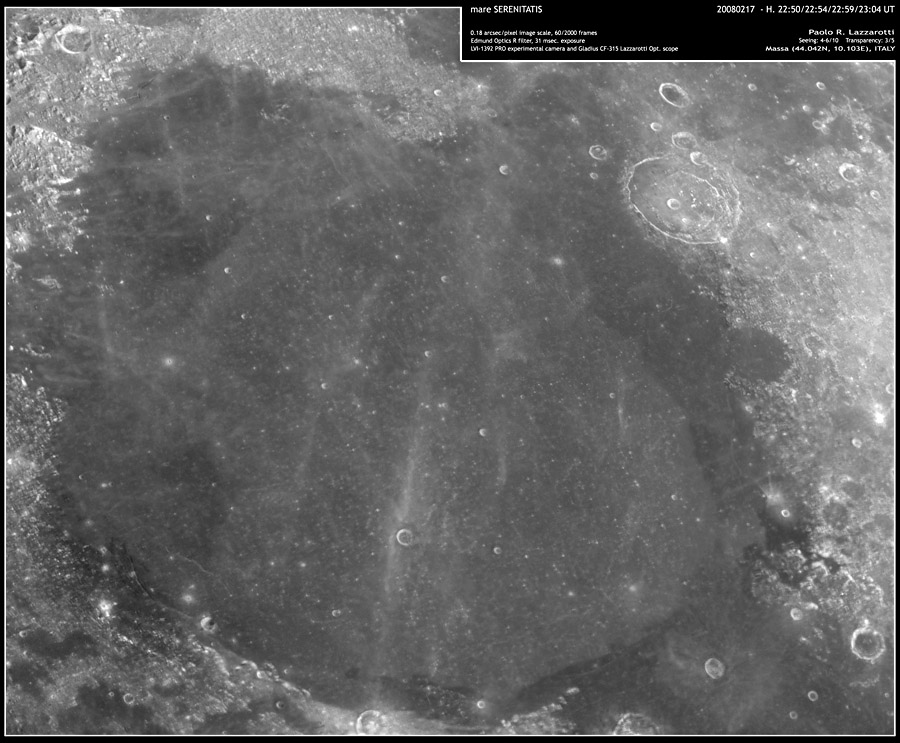Difference between revisions of "December 28, 2017"
(Created page with "__NOTOC__ =Bright Moon= Originally published June 29, 2008 <!-- Start of content --> <!-- ws:start:WikiTextHeadingRule:0:<h1> --> <!-- ws:start:WikiTextLocalImageRu...") |
(No difference)
|
Revision as of 01:04, 28 December 2017
Bright Moon
Originally published June 29, 2008

image by Paolo R. Lazzarotti, Massa, Italy
We are shadow chauvinists. Most lunar images are shot near the terminator where the low illumination highlights subtle variations in topography. This is an excellent way to discover small features and results in dramatic images. But high-Sun views are also needed to reveal variations in albedo (reflectivity) of surface materials. Mare Serenitatis is one of the most pronounced areas of abrupt albedo changes, with the dark collar representing a different mare unit than the brighter material in the center of the mare. And the Apollo 17 landing area (bottom right) is even darker because it is veneered by pyroclastic material. Rays and wispy bright streaks also show up only when the Sun is high. We have previously discussed the uncertain origin of the ray that seems centered on Bessel in the bottom center of Serenitatis, but what are the sources for the crossed streaks at upper left? Rays also identify oblique impact craters - is that a small one near the Apollo 17 landing area? Brightness from steep slopes often makes small rilles easier to see, and here, in the lower left corner, the edge of the Buckland mare ridge is strangely bright - does it have a small steep slope? I encourage imagers to capture high-Sun, high resolution views of every piece of the nearside, both regional perspectives like this, and closeups detailing specific features. The best Earth-based high-Sun photos of the Moon are the 40 year old images in the Consolidated Lunar Atlas. That Atlas used to be the best for low-Sun images of the Moon, but amateurs have exceeded its resolution. Its time to do the same for the high-Sun views.
Chuck Wood
Technical Details
Feb 17, 2008, 22:50-23:04 UT. Gladius CF-315 Lazzarotti Optical telescope + LVI-1392 PRO experimental camera + Edmund Optics R filter, 60/2000 frames.
Related Links
Rükl plates 13, 14, 23 & 24
Yesterday's LPOD: Understanding Swells
Tomorrow's LPOD: Tunguska And the Moon
COMMENTS
1. When it's Full Moon there's much more lunar surface to observe.
-- Danny C.
2. The bright ray pattern to the northwest of the Apollo 17 Site is associated with what the IAU calls Catena Littrow -- near pixel 769,497 in the LPOD photo -- possibly the crater formerly known as Littrow BA. Paolo's image is indeed an improvement in resolution over CLA Plate cii, taken from Earth with nearly identical lighting; but of course, the Earth-based CLA plates have also been superseded by excellent space-based high sun views of much of the equatorial zone by Apollo and pretty good high sun views of the entire Moon by Clementine. For those who might wish to overlay today's LPOD on the CLA plate or the Clementine mosaic, calibration data is available on the LTVT Wiki. -  JimMosher
JimMosher
3. This may sound crazy, but what if the Bessel ray is from Bessel itself. A ratio map close up seems to suggest a possible pattern coming from Bessel itself. It would also fit with the material coloration. Menelaus seems to me to be ruled out because the ejecta would have been older material based on the Ratio. The Bessel ray seems made up of much younger material. The mutlispectral also shows some patterns suggesting an unusal ejection of material. If it is from Bessel the impact might be an oblique because there seems to be lack of material on one side. It wouldn't be the first time that odd ray patterns are caused by oblique impacts. Look at Oblers A with a streamer of material running across the mare. Of course I could be totally wrong as well. -  AndrewMartinSFO
AndrewMartinSFO
4. Andrew - the Bessel ray is mysterious - it looks like it interrupts the ray, but also that Bessel has been surrounded by the mare lava that the ray lies on. Bessel doesn't look like an oblique impact crater and the ray seems too straight.
--Chuck
COMMENTS?
Register, Log in, and join in the comments.



